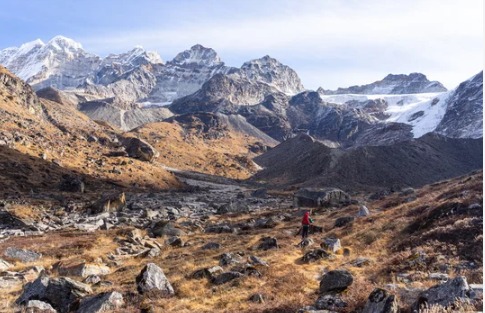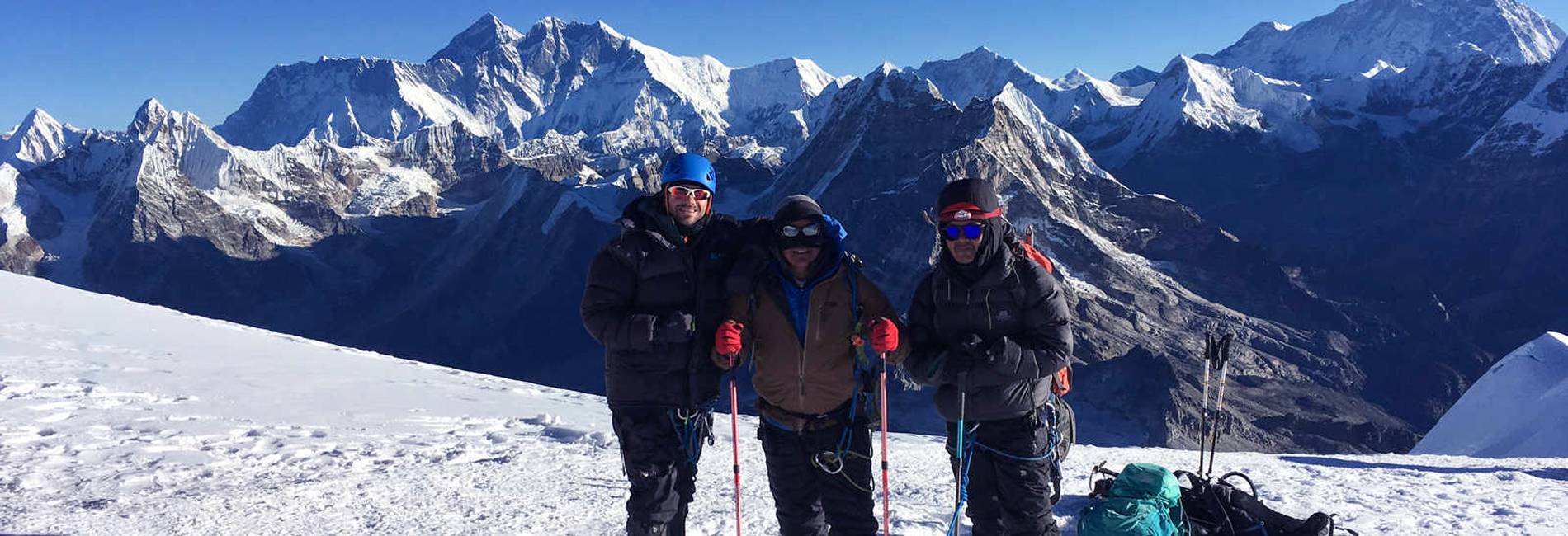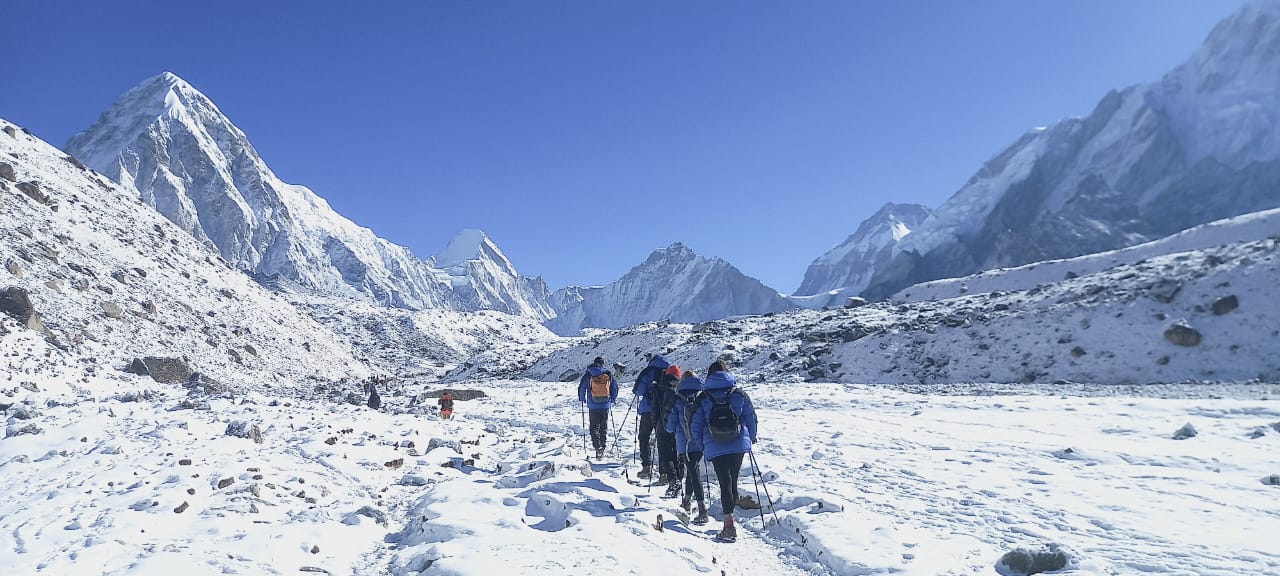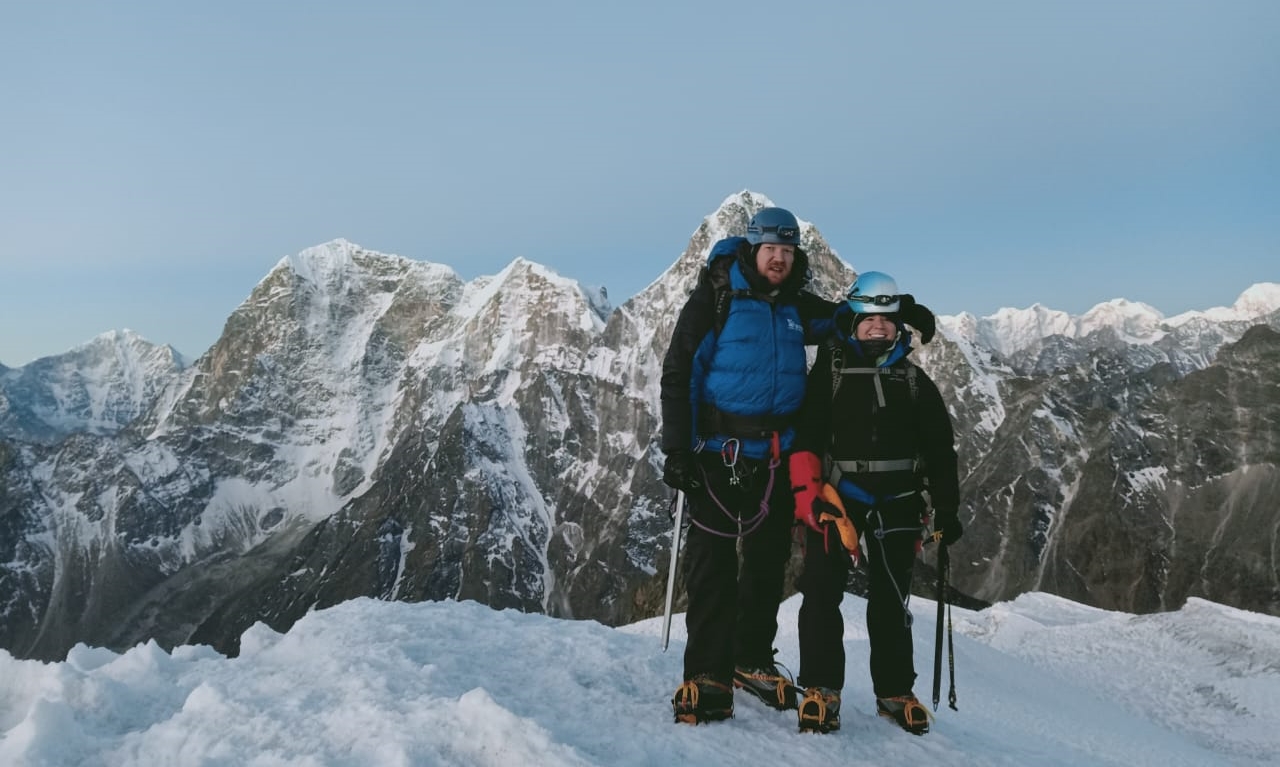26th August, 2025

May 01, 2024
Mera Peak Climbing in February
- Is Mera Peak harder than Kilimanjaro?
- How long does it take to climb Mera Peak?
- Is Mera Peak difficult to climb?
- Is Mera Peak easier than Island Peak?
- Best Time to Climb Mera Peak
- Tips to Remember for a Successful Mera Peak Climbing
- Highlights Of Mera Peak Climbing In February
- How Difficult is Mera Peak Climbing?
- Mera Peak Climbing Permit Cost
- Is This Trip Suitable for Me?
- Physical Fitness and Exercises
- Conclusion
- Mera Peak Climbing Packages
Climbing Mera Peak in February offers a thrilling adventure amidst Nepal's winter season, providing both challenges and rewards for mountaineers. As Nepal's highest trekking peak at 6,476 meters (21,246 feet), Mera Peak stands as a formidable yet attainable goal for those seeking to explore the Himalayas.
February marks the tail end of Nepal's winter, characterized by cold temperatures and stable weather conditions. The days are typically sunny with clear skies, offering excellent visibility for trekking and summit attempts. However, climbers should be prepared for cold temperatures, especially at higher altitudes, where daytime temperatures can range from slightly above freezing to well below freezing. Nighttime temperatures plummet even further, necessitating proper cold-weather gear such as insulated jackets, thermal base layers, hats, gloves, and waterproof outerwear.
The journey to Mera Peak begins with a scenic flight from Kathmandu to Lukla, followed by a trek through traditional Sherpa villages, rhododendron forests, and alpine landscapes. As climbers ascend towards Mera Peak Base Camp and High Camp, they navigate snowy trails and glacier terrain, gradually acclimatizing under the guidance of experienced Sherpa guides.

MERA PEAK CLIMBING 17 DAYS
This is an excellent opportunity to climb Nepal’s highest peak without having to obtain a permit (6,476m/21,190ft). From the summit, you will have stunning views of several 8000m plus peaks, such as E...
Summit day typically starts early to capitalize on stable weather conditions and clear skies. The climb from High Camp to the summit is non-technical but challenging due to altitude and snowy slopes, requiring stamina and determination. From the summit, climbers are rewarded with breathtaking panoramic views of Everest, Lhotse, Makalu, and other Himalayan giants stretching across the horizon.
Choosing February for Mera Peak climbing ensures a quieter trekking experience with fewer climbers on the trail compared to peak seasons. It allows adventurers to immerse themselves in the tranquility of Nepal's winter wilderness while experiencing the thrill of summiting one of its highest peaks. With proper preparation, including physical conditioning, acclimatization, and the guidance of seasoned Sherpa guides, climbing Mera Peak in February promises an unforgettable Himalayan adventure filled with achievement and natural beauty.
Comparing Mera Peak with Kilimanjaro, Island Peak, and assessing its difficulty and climbing duration provides insights into each mountain's unique challenges and characteristics.
Is Mera Peak harder than Kilimanjaro?
Mera Peak, situated in Nepal's Khumbu region, is renowned for being the highest trekking peak in the country, standing at 6,476 meters (21,246 feet). Unlike Kilimanjaro, which is Africa's highest peak but a non-technical trek, Mera Peak involves basic mountaineering skills due to glacier crossings and moderate snow slopes. The climb to Mera Peak requires physical endurance and proper acclimatization to manage the altitude and cold weather conditions. Kilimanjaro, on the other hand, involves hiking through different ecosystems but does not require technical climbing skills. Thus, while both peaks present challenges, Mera Peak's higher altitude and glacier travel make it more physically demanding and technically challenging than Kilimanjaro.

MERA PEAK CLIMBING
Mera Peak Climbing is an exhilarating adventure in Nepal that gives you an opportunity to reach the summit of Mera Peak at more than 6400m above sea level. Actually, it is the highest climbing (w...
How long does it take to climb Mera Peak?
Climbing Mera Peak typically takes around 15 to 18 days, depending on the chosen itinerary and weather conditions. The journey begins with a flight from Kathmandu to Lukla, followed by a trek through Sherpa villages, rhododendron forests, and alpine landscapes towards Mera Peak Base Camp. Acclimatization days are crucial for adjusting to the altitude before ascending to High Camp and making the summit push. The climb itself usually takes about 8 to 10 hours from High Camp to the summit and back, allowing time for rest breaks and adjusting to weather conditions. The descent follows a similar route back to Lukla, culminating in a flight to Kathmandu.
Is Mera Peak difficult to climb?
Mera Peak is challenging but achievable for climbers with good physical fitness and basic mountaineering skills. The climb is non-technical but involves navigating through glacier terrain and snow slopes. The primary challenges include altitude, cold temperatures, and potential weather changes. Proper preparation, including cardiovascular training, strength conditioning, and altitude acclimatization, is essential. Experienced Sherpa guides play a crucial role in ensuring safety, providing guidance on route navigation, and managing logistics throughout the expedition.

MERA PEAK EXPEDITION 14 DAYS
The Mera Peak Expedition is a 14-day trek that offers a unique and challenging route to the summit of Mera Peak. The Upper Route is a less-traveled path that takes you through some of the most remote...
Is Mera Peak easier than Island Peak?
Comparing Mera Peak with Island Peak (Imja Tse), another popular trekking peak in Nepal, reveals differences in technical difficulty and altitude challenges. Mera Peak, while higher in elevation at 6,476 meters (21,246 feet), is generally considered less technical than Island Peak, which requires traversing steep ice and rock faces with fixed ropes and climbing equipment. Island Peak demands higher proficiency in technical climbing skills and experience with glacier travel compared to Mera Peak's non-technical ascent. Therefore, while both peaks require physical preparation and acclimatization, Mera Peak may be perceived as more accessible to climbers with basic mountaineering skills seeking a challenging yet achievable Himalayan summit.
In conclusion, Mera Peak stands as a challenging yet attainable peak for climbers looking to explore Nepal's Himalayas. It offers a blend of physical endurance, technical skill, and breathtaking views, making it a memorable adventure for those prepared to undertake its ascent.
Best Time to Climb Mera Peak
The best time to climb Mera Peak is during the pre-monsoon (spring) and post-monsoon (autumn) seasons in Nepal, which typically span from March to May and September to November respectively. These months offer stable weather conditions, clear skies, and moderate temperatures, making trekking and summit attempts more favorable. The visibility is excellent, showcasing panoramic views of the Himalayan peaks, including Everest, Lhotse, and Makalu. Additionally, the trails are well-defined and less prone to snow and ice, enhancing safety and accessibility for climbers.
Tips to Remember for a Successful Mera Peak Climbing
- Physical Conditioning: Prioritize cardiovascular fitness, strength training, and endurance exercises to prepare for the physical demands of high-altitude trekking and climbing.
- Acclimatization: Allow ample time for acclimatization with gradual ascents and rest days to prevent altitude sickness and improve summit success rates.
- Gear Preparation: Pack appropriate gear, including insulated clothing, waterproof layers, sturdy hiking boots, and technical climbing equipment like crampons and ice axes.
- Hydration and Nutrition: Stay hydrated and maintain a balanced diet to sustain energy levels during the trekking and climbing phases.
- Follow Local Guidance: Listen to experienced Sherpa guides for route navigation, safety protocols, and weather updates throughout the expedition.

MERA PEAK CLIMBING 15 DAYS
The Mera Peak Expedition is a 15-day trek that takes you through some of the most stunning landscapes and challenging trails in Nepal. Mera Peak is the highest trekking peak in Nepal, standing at 6,47...
Highlights Of Mera Peak Climbing In February
Climbing Mera Peak in February offers a unique adventure amidst Nepal's winter season. The landscape is covered in pristine snow, creating a magical ambiance for trekkers. Clear skies and stable weather conditions provide excellent visibility for admiring the surrounding Himalayan peaks. The journey includes trekking through Sherpa villages, dense forests, and alpine meadows, offering insights into local culture and traditions. Summiting Mera Peak rewards climbers with breathtaking panoramic views, including Mount Everest, Nuptse, and Cho Oyu, stretching across the horizon.
How Difficult is Mera Peak Climbing?
Mera Peak climbing is considered challenging but feasible for climbers with basic mountaineering skills and good physical fitness. The route involves non-technical terrain, including glacier crossings and moderate snow slopes. The primary challenges include high altitude, cold temperatures, and potential weather changes. Proper preparation, including cardiovascular training, strength conditioning, and altitude acclimatization, is essential. With the guidance of experienced Sherpa guides, many climbers successfully summit Mera Peak each year, enjoying the accomplishment and stunning scenery.

MERA AND ISLAND PEAK CLIMBING
Embark on a thrilling mountaineering adventure like no other with the Mera and Island Peak Climbing expedition crafted by We Sherpa Expedition and Trekking. This exclusive package is designed for adve...
Mera Peak Climbing Permit Cost
The cost of climbing permits for Mera Peak includes the Sagarmatha National Park Entry Permit and the Mera Peak Climbing Permit issued by the Nepal Mountaineering Association (NMA). These permits contribute to conservation efforts and ensure access to designated trekking routes and climbing peaks in the Everest region. Permit costs vary depending on the season and nationality of climbers, typically ranging from USD 500 to USD 600 per person. It's essential to obtain permits through a licensed trekking agency like Sherpa Expedition to ensure compliance with regulations and smooth logistics during the expedition.
Is This Trip Suitable for Me?
Climbing Mera Peak is suitable for individuals with a sense of adventure, good physical fitness, and a willingness to undergo proper preparation and acclimatization. While prior trekking experience is beneficial, basic mountaineering skills can be learned during the expedition under the guidance of experienced Sherpa guides. The trip appeals to climbers seeking a challenging yet achievable summit experience in Nepal's Himalayas, with opportunities to explore remote landscapes and cultural heritage along the way.
Physical Fitness and Exercises
Physical fitness is crucial for Mera Peak climbing, requiring endurance, strength, and cardiovascular conditioning. Incorporate regular aerobic exercises such as hiking, jogging, or cycling to improve stamina. Strength training with focus on legs, core, and upper body helps in carrying backpacks and navigating challenging terrain. Additionally, practice altitude acclimatization with gradual ascents and regular hydration during training to prepare for high-altitude challenges. Consulting with a healthcare professional before departure ensures physical readiness for the expedition.

LOBUCHE PEAK CLIMBING
Lobuche East (6,119m/20,075ft), set in Nepal's stunning Khumbu on the Nepalese side of Everest.The best time to go trekking in Nepal is in Autumn (September-November) and in...
Conclusion
Climbing Mera Peak offers an exhilarating adventure in Nepal's Everest region, combining stunning landscapes with a challenging ascent to one of the country's highest trekking peaks. The best time to climb is during spring and autumn for favorable weather conditions and clear views. Proper preparation, including physical conditioning, gear selection, and acclimatization, enhances safety and success rates. With careful planning and the support of experienced Sherpa guides, climbers can conquer Mera Peak, savoring the achievement and unforgettable moments amidst the Himalayan beauty.
Mera Peak Climbing Packages
Mera Peak Summit Return By Helicopter

ISLAND PEAK CLIMBING
Sherpa Expedition & Trekking (Est.1977) are pleased to announce FOR ADVENTURERS the most awesome, exhilarating & unforgettable climbing and treks on offer anywhere today!...
Any Questions? Let Us Know.
Recent Posts
17th June, 2025


















